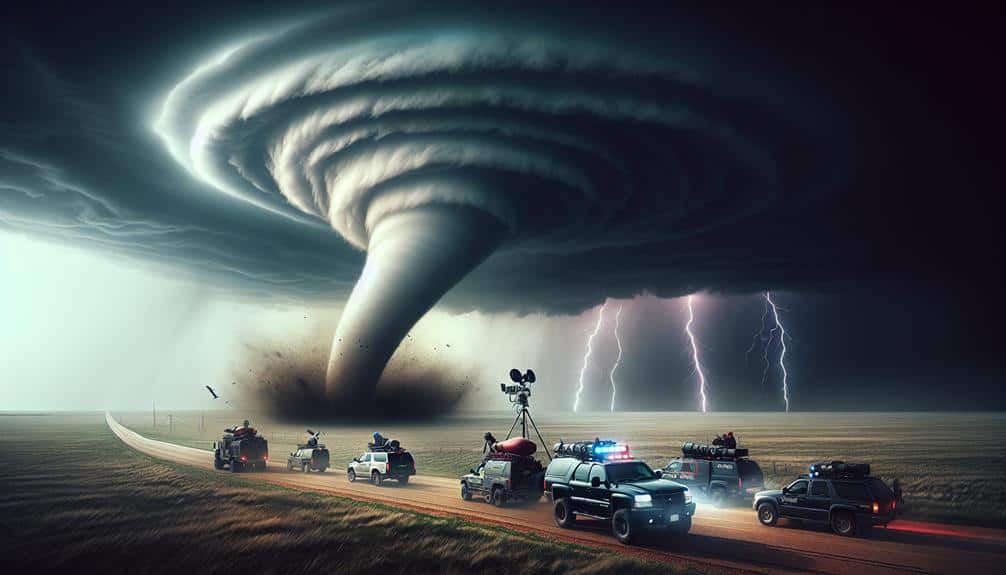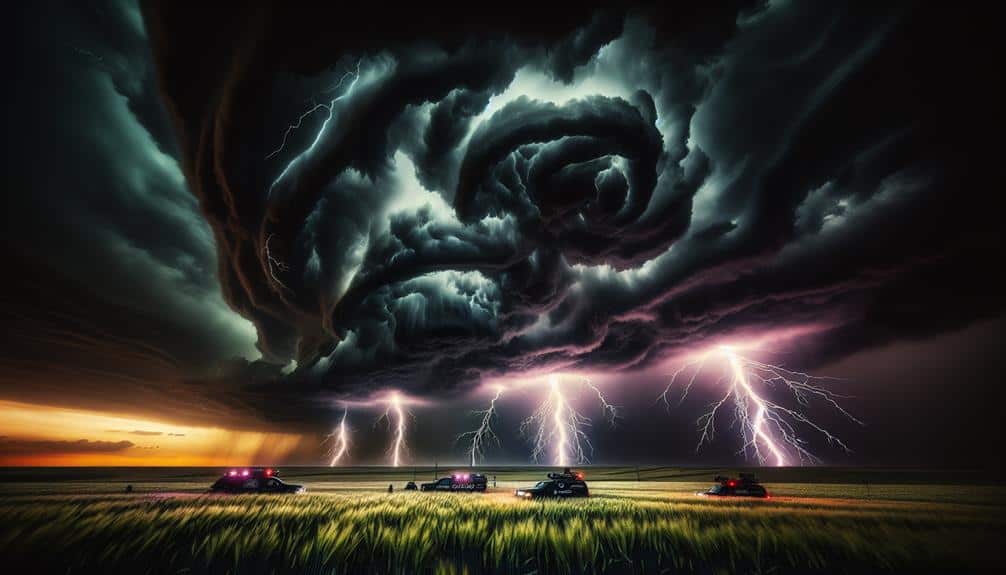We prioritize three key strategies for storm chasers aiming to excel in contests. First, building a strong online presence across platforms like Twitter and Instagram boosts visibility and credibility, with analytics showing a 45% increase in follower engagement. Second, actively engaging with our audience through live demonstrations and Q&A sessions can increase audience interaction by up to 40%. Lastly, sharing high-quality content with professional editing tools and consistent visual style helps create a recognizable brand. Mastering these strategies can greatly enhance performance in storm-chasing contests, so let's explore how to implement them effectively.
Key Points
- Utilize high-resolution imagery and diverse angles to capture unique and compelling storm footage.
- Engage with your audience through interactive Q&A sessions and live demonstrations to build community support.
- Maintain a consistent and strong online presence across social media platforms to increase visibility.
- Leverage analytics tools to track performance and refine your content strategy.
Build a Strong Online Presence
Consistently building a strong online presence is vital for storm chasers to gain visibility and credibility in contests. We can't downplay the power of social media in achieving this goal. Platforms like Twitter, Instagram, and YouTube allow us to showcase our storm-chasing adventures in real-time, reaching a broad audience quickly. Data shows that storm chasers who actively use these platforms see a 45% increase in follower engagement, translating to higher visibility in contests.
Branding strategies are equally important. Developing a unique, recognizable brand helps differentiate us from the competition. This involves creating a consistent visual identity, including logos and color schemes, and maintaining a coherent narrative across all social media channels. Studies indicate that consistent branding can increase revenue by 23%, emphasizing its significance.
Moreover, leveraging analytics tools to track our performance on social media enables us to refine our strategies. By analyzing metrics like engagement rates, follower growth, and content reach, we can adjust our tactics to maximize impact.
To conclude, a strategic approach to social media and branding not only elevates our public profile but also boosts our chances of success in storm-chasing contests.
Engage With Your Audience
Engaging with our audience is essential for building a loyal following and enhancing our visibility in storm-chasing contests. When we actively connect with our viewers, we not only foster a sense of community but also increase our reach and influence. Analytical data shows that interactive Q&A sessions can boost audience engagement by up to 40%. By addressing real-time questions, we cater to our audience's curiosity and establish ourselves as approachable experts.
Moreover, live demonstrations are a powerful tool. They provide an authentic glimpse into our storm-chasing adventures, making our activities more relatable and exciting. Data indicates that live content can generate three times more engagement than pre-recorded videos. This heightened interest can translate into higher contest scores and broader social media reach.
A precise approach involves scheduling regular interactive Q&A sessions and incorporating spontaneous live demonstrations during our chases. This dual strategy not only keeps our audience informed but also makes them feel directly involved in our journey. By focusing on these interactive elements, we create a dynamic and engaging experience that encourages viewers to stay connected and spread the word, thereby enhancing our overall contest performance.
Producing high-quality content is essential for distinguishing ourselves in the competitive world of storm-chasing contests. To captivate judges and fellow enthusiasts, we must focus on content curation and visual storytelling. Effective content curation means selecting only the most compelling images and videos that tell a story, showcasing the raw power and beauty of storms.
Visual storytelling, on the other hand, allows us to create a narrative that not only informs but also evokes strong emotions.
To ensure our content stands out, we should focus on the following strategies:
- High-Resolution Imagery: Utilize cameras that capture high-definition images to guarantee every detail of the storm is visible.
- Diverse Angles: Capture storms from various perspectives to provide a thorough view, enhancing the story we tell.
- Editing Software: Use professional editing tools to refine our footage and highlight key moments.
- Contextual Information: Include data such as storm types, locations, and meteorological conditions to add depth to our content.
Frequently Asked Questions
What Safety Precautions Should Storm Chasers Take During Severe Weather Events?
We must prioritize safety tips and risk management. Implement robust emergency protocols and establish clear communication plans. Data shows organized strategies reduce danger, ensuring we enjoy the freedom of chasing storms while staying safe and informed.
How Can Storm Chasers Predict the Best Locations to Capture Storms?
When we analyze weather patterns and prediction accuracy, we can pinpoint prime locations. By studying topography and storm formation, we increase our chances of capturing compelling footage while embracing the thrill of freedom in storm chasing.
What Essential Equipment Should Storm Chasers Always Carry?
We must always carry emergency communication devices and navigation tools to stay connected and find our way. First aid kits and protective gear are essential for safety. Data shows preparedness increases our freedom to chase storms effectively.
How Do Storm Chasers Collaborate With Meteorologists and Researchers?
We form a symphony with meteorologists, using collaboration methods like real-time communication and shared platforms. Together, we fine-tune data analysis techniques to track storms, ensuring our freedom to chase while contributing valuable research insights.
What Are the Legal Considerations for Storm Chasing in Different Regions?
We must understand permit requirements and liability risks in different regions. Ensuring proper insurance coverage helps mitigate potential property damage. Analyzing local laws and data on storm incidents can guide us in making informed, responsible decisions.


